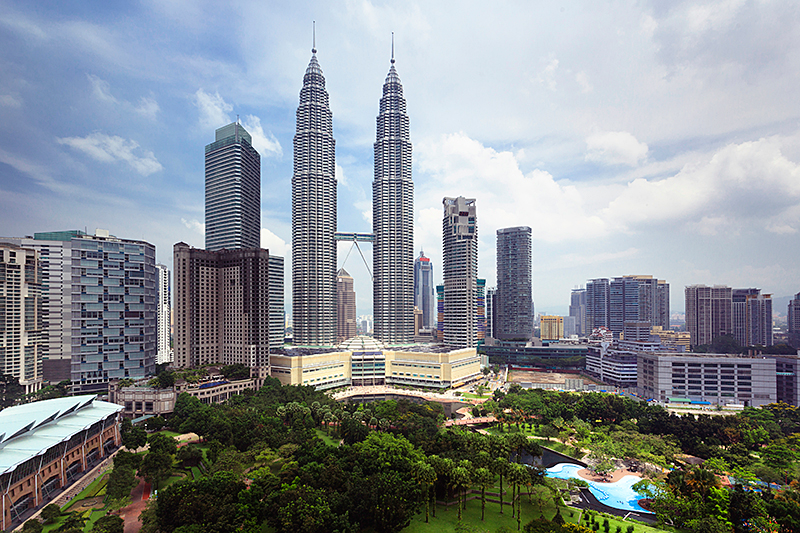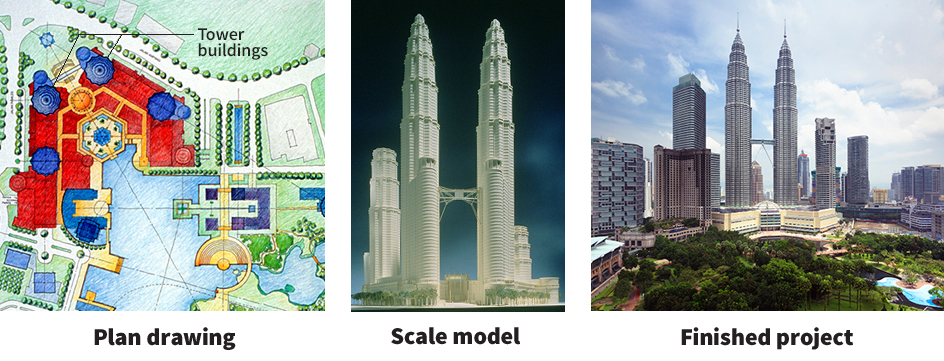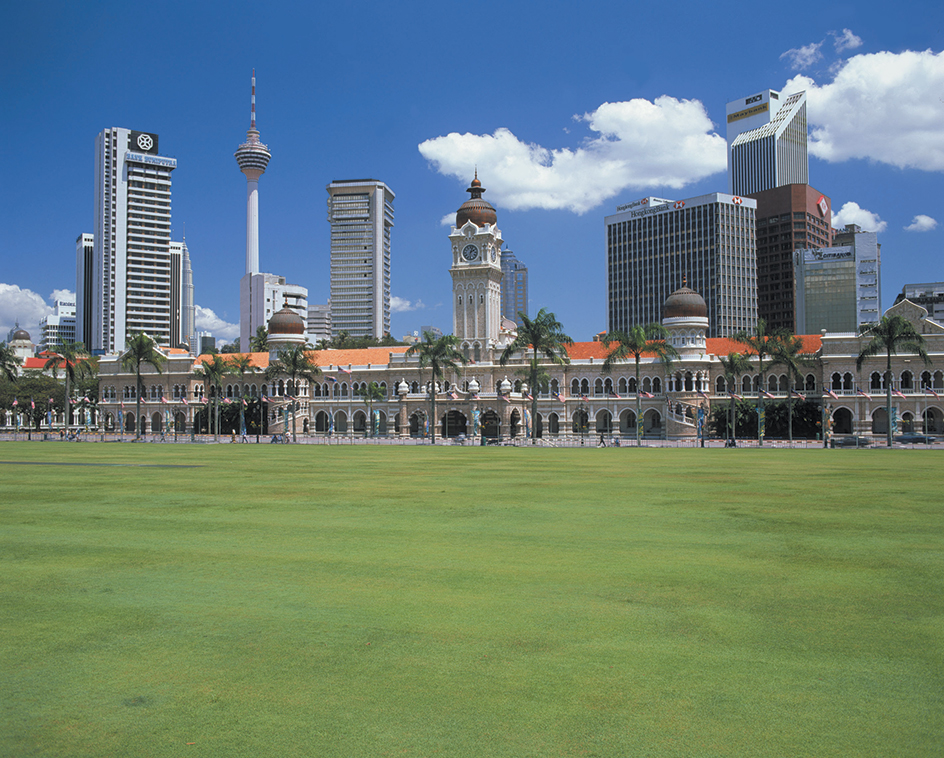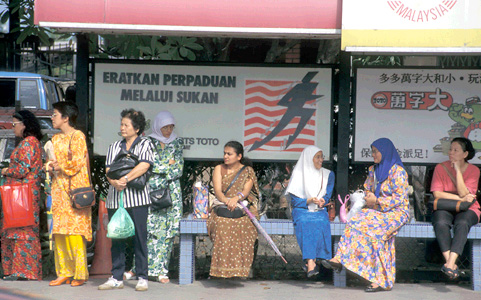Kuala Lumpur, << KWAH luh loom POOR >> (pop. 1,541,553), is the capital and largest city of Malaysia. It is also the country’s most important commercial center.

The city of Kuala Lumpur occupies just over one-third of the Federal Territory area of Kuala Lumpur. It lies in the Kelang Valley, midway between George Town and Singapore.
City.
The Kuala Lumpur metropolitan area includes several old settlements such as Kepong, Gombek, Ampang, and Sungai Besi. All of these former towns now have new housing estates.

Kuala Lumpur spreads out from the junction of the Klang and Gombak rivers, and lies along both banks of the rivers. The part of the city east of the two rivers has high-rise buildings, small shops, a busy outdoor market, and mosques (Muslim houses of worship). The area west of the rivers includes modern government buildings, the National Museum, and the National Mosque. The city is the home of the University of Malaya, and of agricultural, technical, and teachers’ training colleges. The National University of Malaysia is south of the city.
Most of Kuala Lumpur’s oldest buildings were constructed after a fire destroyed the city in the 1880’s. Their design is patterned after Moorish architecture. This style, which developed in northern Africa, features arches, domes, towers, and spiral staircases.
Kuala Lumpur attracts many tourists. Popular sites include the National Mosque, which has 48 domes. One of the domes is in the shape of an 18-pointed star. The points represent the 13 states of Malaysia and the 5 Pillars of Islam.
The Malaysian national government employs many of Kuala Lumpur’s people. The city is a center of banking, trade, and other commercial activities. Its industries include rubber, tin, and food processing; and the production of textiles and electronic products. The new Kuala Lumpur International Airport opened in June 1998. There is also an airport in Subang.
During the late 1900’s, the city’s population grew rapidly. The rapid growth of the city has caused several problems, including population pressure on land and roads, inadequate housing and public transport, and shortage of recreational space.
Parliament House and government ministries are west of the Kelang River. Skyscrapers in the northern and western sections of the city house the headquarters of major Malaysian companies and banks as well as those of multinational corporations and international hotels. They include the Petronas Towers, which are among the world’s tallest skyscrapers. There are several universities and colleges in and around the city.
The city has many places of worship for people of various religions. Malays are mostly Muslims and the National Mosque can accommodate many thousands of people. There are also many Christian churches and Hindu and Buddhist temples.

Kuala Lumpur is a medium-size capital city which blends its colonial past with traditional shops and modern skyscrapers. Petaling Street is the Chinatown of Kuala Lumpur. It is a typical Chinese business district with traditional covered footways and shophouses, which have shops on the ground floor and family homes upstairs. The shops and street stalls offer a variety of goods, food, fruit, and souvenirs. The street becomes a pedestrian area at sunset, crowded with shoppers and tourists. Traditional products, such as batik, pewterware, and handicrafts, are also available in these shops and night markets (see Batik ). There is a handicraft center containing traditional Malay houses which present and sell the crafts of each of the Malaysian states.
To the west of Kuala Lumpur is Petaling Jaya, the first new town (specially planned town) of Malaysia and a sprawling residential, industrial and commercial center. Its middle-class community commutes daily to work in the city. Petaling Jaya is now one of the largest towns in the country, with a population of 176,131.
Places of interest.
Along Jalan Sultan Hishamudin are several of the city’s most distinctive architectural landmarks. Three buildings feature Moorish architectural styles with curving arches, domes, or minarets. These buildings include the old city hall, which was completed in 1897. The railway station and the Malayan Railway Administration Building date from the early 1900’s. The Sultan Abdul Samad Building, where the state secretariat was formerly housed, was completed in 1897. It has a 141-foot (43-meter) copper-sheathed clock tower.

The National Museum is a striking building based on old Malay-style architecture. It has displays relating to Malaysian arts and crafts and history as well as the country’s birds and mammals.
The National Monument is in the Tun Abdul Razak Heritage Park. This bronze sculpture commemorates the triumph of democracy over the Communist terrorism which had led to the proclamation of a state of emergency in 1948.
The six-tiered Thean Hou Temple, on a hill slope just outside the city center, is one of the biggest Chinese temples in Southeast Asia.
The National Zoo has about 200 species of mammals, birds, and reptiles, from Malaysia and other countries. It also has an aquarium with more than 80 species of aquatic animals.
People.
Nearly half of the population of Kuala Lumpur are Chinese. About two-fifths are Malays, and most of the rest are Indians. The population has increased to more than three times its level at the time of Malayan independence in 1957. The food of Kuala Lumpur reflects the variety of the multiracial population. In roadside shops and in hotels, dishes available include food from Malays, Chinese, Indians, and other ethnic groups.

History.
Kuala Lumpur means “muddy river mouth.” It derives its name from its location at the meeting place of the Kelang and Gombek rivers. Founded as a tin mining settlement in 1859, it became the capital of Selangor in 1887 and of the Federated Malay States of Selangor, Perak, Negeri Sembilan, and Pahang in 1896.
Prosperity developed from the success of mining and rubber planting. Kuala Lumpur became a center of commerce and transport, and acquired its cosmopolitan character with Malay settlers, Chinese shopkeepers, Indian labourers, British administrators, and Arab traders.
Kuala Lumpur progressed from a town council in 1898 to a municipality in 1948. It became the capital of the Federation of Malaya in 1957 and of Malaysia in 1963. In 1972, it was proclaimed a city, and in 1974, it became the core city of the Federal Territory area of Kuala Lumpur.
See also Kuala Lumpur ; Malaysia ; Petronas Towers .
